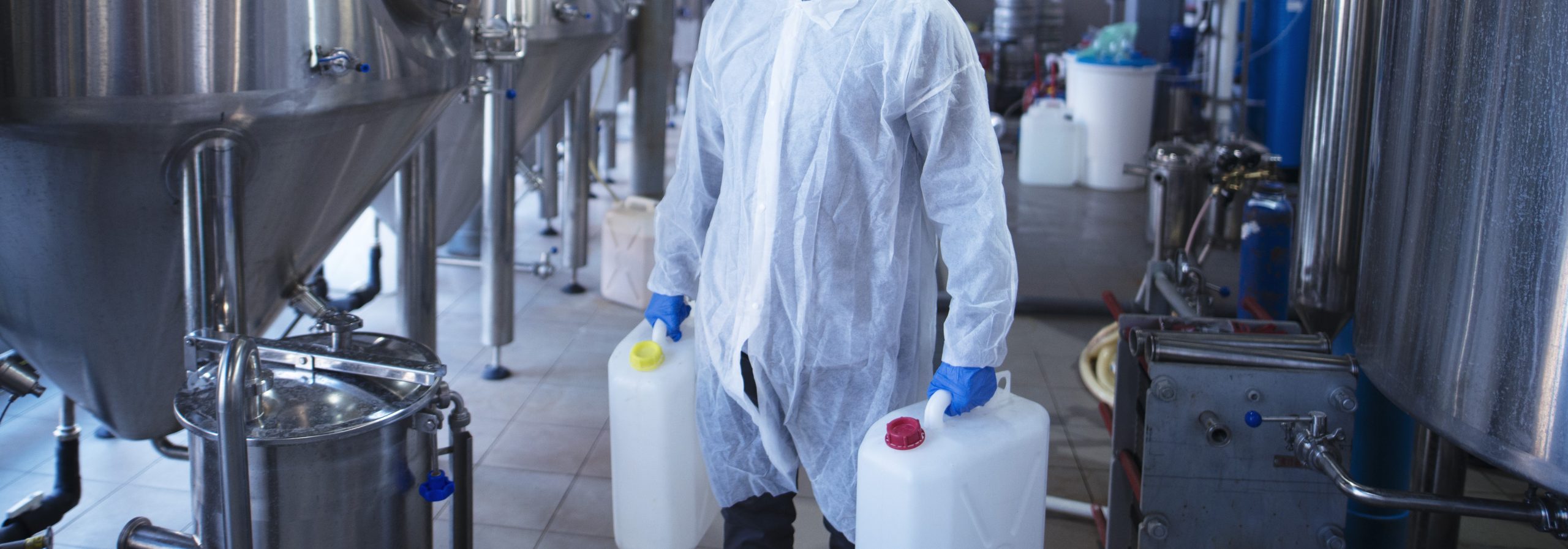Chemical spills in manufacturing facilities pose a significant risk to workers, nearby communities, and the environment. A recent incident in Clovis, New Mexico has brought this issue into sharp focus, highlighting the dangers inherent in handling hazardous materials and the severe consequences of safety failures. Industrial chemical spills can lead to fires, toxic exposure, environmental damage, and long-term health issues for those affected. For victims, navigating the aftermath can be overwhelming, particularly when it comes to understanding their legal rights and holding responsible parties accountable.
In the blog below, the workplace chemical injury attorneys at Kherkher Garcia explore the Clovis incident and examine the broader implications of chemical spills in manufacturing. From the common causes of these accidents to the steps victims can take to seek compensation, we aim to shed light on this pressing safety issue and provide guidance for those impacted by industrial negligence.
Clovis Chemical Spill Injures Multiple Workers
The Curry County Sheriff’s Office states that, at 9:15 a.m. on Monday morning, it was notified of an incident at the Southwest Cheese factory in Clovis. Sheriff’s deputies along with the Clovis Fire Department arrived a short time later. The Sheriff’s Office said that 8.67 gallons of acid spilled and mixed with .61 gallons of chlorine due to equipment malfunction. This created the chemical mixture that resulted in 20 employees being injured because of the toxic gas.
At least 14 people were transferred to two local hospitals. At least two workers remain in critical condition. New Mexico State Police is working with the factory in cleaning the chemicals. The Clovis Fire Department Hazardous Materials Response Team was also called to the scene. The cause of the equipment malfunction and leak is being investigated. The sheriff’s office also said there is no threat to the public and the chemical release was contained.
Founded in 2005, Southwest Cheese Factory is a global manufacturer of cheese and whey protein ingredients. The company processes milk and produces premium block cheese as well as highly-purified whey protein powders each year.
The Prevalence and Hazards of Chemical Spills in Manufacturing Facilities
Manufacturing facilities often handle large volumes of hazardous chemicals essential to production processes. Despite rigorous safety protocols, accidents can still occur due to equipment malfunctions, human error, or inadequate safety measures. These spills can result in:
- Toxic Gas Releases: When certain chemicals mix, they can generate harmful gases that spread rapidly, endangering workers and nearby communities.
- Environmental Contamination: Spills can infiltrate water supplies, soil, and air, causing long-term ecological damage.
- Explosions and Fires: Many industrial chemicals are highly flammable, and a spill can lead to catastrophic explosions.
- Direct Contact Injuries: Workers exposed to spilled chemicals may suffer burns, respiratory issues, or other acute health problems.
In facilities handling chlorine and acids, the risks are particularly severe. Chlorine is a potent irritant, and its reaction with acids can create chlorine gas, a highly toxic and corrosive substance.
The Dangers of Mixing Chlorine and Acid
When chlorine and acid mix, the result is a chemical reaction that produces chlorine gas (Cl₂), a yellow-green gas that was infamously used as a chemical weapon during World War I. Even in small amounts, chlorine gas poses a serious threat to human health.
Chlorine-containing compounds, such as sodium hypochlorite (common in bleach), react with acids like hydrochloric acid. The reaction liberates chlorine gas, which can spread quickly in an enclosed space, increasing the risk of widespread exposure.
Health Risks of Chlorine Gas Exposure:
- Respiratory Injuries: Chlorine gas irritates the respiratory tract, causing coughing, choking, and difficulty breathing. Severe exposure can lead to pulmonary edema, a life-threatening condition where fluid fills the lungs.
- Eye and Skin Irritation: Direct contact with chlorine gas can cause burning sensations, redness, and chemical burns.
- Neurological Effects: High levels of exposure can cause dizziness, headaches, and in extreme cases, loss of consciousness.
- Long-Term Effects: Chronic exposure may result in asthma-like symptoms, reduced lung function, and persistent respiratory issues.
Injuries Resulting from Chemical Spills and Toxic Exposure
Chemical spills, particularly those involving toxic gas releases, can cause a wide range of injuries, including:
- Burns and Skin Damage: Direct contact with spilled chemicals often results in chemical burns, which can range from superficial irritation to deep tissue damage. Prolonged exposure may exacerbate injuries.
- Respiratory Conditions: Inhalation of toxic fumes can lead to acute respiratory distress, asthma, or chronic lung diseases such as bronchitis. Severe cases may result in permanent lung damage or death.
- Neurological Symptoms: Chemical exposure can cause dizziness, headaches, nausea, and confusion. In some cases, high exposure levels may lead to long-term neurological impairments.
- Eye Injuries: Many chemicals are highly corrosive to eye tissue, leading to vision loss if exposure is not immediately treated.
- Systemic Toxicity: Some chemicals are absorbed into the bloodstream, causing widespread damage to internal organs, including the liver, kidneys, and central nervous system.
- Fatalities: In the most severe cases, exposure to high concentrations of toxic chemicals can result in death, either from immediate effects or complications arising later.
Workers’ Rights After Chemical Injuries
Workers who suffer injuries due to chemical spills in manufacturing facilities have legal rights designed to protect their health, safety, and financial stability. Understanding these rights is crucial for seeking appropriate compensation and ensuring accountability.
- Workers’ Compensation Benefits: Most states require employers to carry workers’ compensation insurance, which provides benefits to employees injured on the job. These benefits typically include:
- Medical coverage for treatment and rehabilitation.
- Partial wage replacement during recovery.
- Disability benefits for long-term or permanent injuries.
- Death benefits for the families of workers who lose their lives due to workplace incidents.
- Third-Party Claims: If a chemical spill results from defective equipment, improper maintenance by an external contractor, or other third-party negligence, injured workers may be able to file a personal injury lawsuit against the responsible party in addition to receiving workers’ compensation benefits.
- OSHA Complaints: The Occupational Safety and Health Administration (OSHA) enforces workplace safety standards to prevent chemical spills and related hazards. Workers have the right to report unsafe conditions to OSHA without fear of retaliation.
- Legal Protections Against Retaliation: Federal and state laws protect employees who report unsafe conditions or seek compensation for workplace injuries from retaliation, including wrongful termination, demotion, or harassment.
- Litigation Against Employers: While workers’ compensation laws generally shield employers from lawsuits, exceptions may apply in cases involving intentional misconduct or gross negligence.
Steps Workers Should Take After Chemical Spills
If you are injured in a chemical spill at a manufacturing facility, taking the following steps can protect your health and your legal rights:
- Seek Immediate Medical Attention: Prompt medical evaluation is essential to assess and document injuries. Ensure you follow the recommended treatment plan.
- Report the Incident: Notify your employer or supervisor about the spill and your injury. File an incident report detailing what happened.
- Document the Scene: If possible, take photographs or videos of the spill area, including any visible injuries or hazardous conditions.
- Consult an Attorney: An experienced workplace injury attorney can help you navigate the claims process, ensure your rights are protected, and explore additional legal options if third-party negligence is involved.
- File a Workers’ Compensation Claim: Submit your claim promptly to avoid delays in receiving benefits.
How Kherkher Garcia Can Help
At Kherkher Garcia, we understand the devastating impact that chemical injuries can have on workers and their families. Our experienced attorneys are dedicated to advocating for victims of workplace accidents and ensuring they receive the compensation and support they deserve.
We provide comprehensive legal services, including:
- Investigating the cause of chemical spills and identifying liable parties.
- Assisting with workers’ compensation claims to maximize benefits.
- Filing third-party lawsuits against manufacturers, contractors, or other negligent entities.
- Representing clients in OSHA-related matters and whistleblower cases.
By holding employers and third parties accountable, we aim to improve workplace safety standards and secure justice for injured workers.
Free Consultation with a Workplace Chemical Injury Attorney
Chemical spills in manufacturing facilities, particularly those involving the dangerous interaction of chlorine and acid, present serious risks to worker health and safety. These incidents underscore the importance of stringent safety measures, robust response protocols, and legal protections for affected employees.
If you or a loved one has been injured in a chemical spill, it is vital to seek immediate medical care and consult with a skilled attorney to understand your rights and pursue fair compensation. Contact Kherkher Garcia today to schedule a free consultation and learn how we can help you navigate this challenging time. Call us at 713-333-1030, or submit our online contact form to get started.
Image by aleksandarlittlewolf on Freepik


